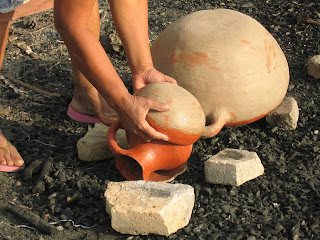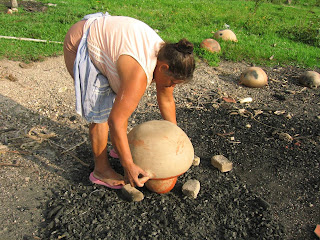
First, you let the ceramics sit in the sun for a few hours.

Next, using something to keep the ceramics from touching the coals beneath (in this case bricks and pieces of broken pots that have cracked in the sun), you stack the pottery upside down, placing the smaller pieces in the larger pots and making miniature “ovens”.

The pans and pitchers (or anything that has already been painted) must be inside the larger pots or the color will get ruined.

Once all the little pieces are hidden inside the miniature ovens, the rest of the larger pots are stacked upside down one on top of the other.

The most costly part of the whole process is the amount of wood it takes to fire the pots. Firewood (leña) can either be bought or people can go and collect it themselves. Wood is placed around and on top of the stack of pots until they are all completely hidden.

Then, small pieces of kindling (called ocote) are lit and spread around the whole heap until the fire burns evenly.


I honestly had never seen a fire that huge and intimidating! The flames got to be about 6 feet tall and even from ten feet away, my forearms were getting burned. It was a very windy day so we had to be careful because even from 15 feet back if the wind changed, you could feel the burn! (I like this photo because you can see the intensity of the fire and also Celaque is in the background).

Moncha let the fire go for about 30 to 45 minutes, or once the pots start to turn white. When they start to turn white, she uses a long stick to knock the wood away. But even from that distance she has to move in quickly, try to knock some wood down, and then turn back because the heat burns her face.

If the pottery is not fired for long enough, it will eventually crack. But if it is fired for too long, it will crack. So it’s a process that takes careful scrutiny. Once all the wood is removed, the pots are left to cool.

Then, all that is left is to paint the ones that have not already been painted and then sell them! Moncha’s mother taught her this whole process of making ceramics and it is a very traditional and famous Lencan practice that has been passed down through the years. And as Moncha learned from her mother, she has taught her daughter, Francis, to carry on this unique cultural tradition.
While Moncha tells me she sells a fair amount in Gracias, it’s hard to depend on this income as it varies according to how many tourists are around and how much they want to buy Lencan artwork. However, I think there is a lot of potential to expand and diversify this market and so hopefully I will be working more with these women concerning that or with ecotourism, trying to bring more tourists here.



Ceramics and pottery in a storehouse in La Campa ready to be sold in Gracias (these aren`t actually Moncha`s work)

3 comments:
Hi Sweetie,
The information was very good but Dad and I couldn't open the photos; I know they are excellent, too.
Thank you for sharing such interesting information; it is a joy reading what you write. Thinking of you with love, Mom
Hey,
Im glad your having a good time. I couldnt see the pics either :(
the pics are finally working!!!
Post a Comment